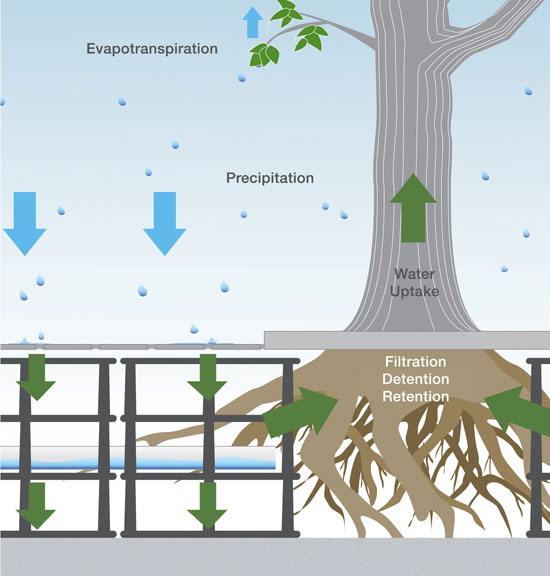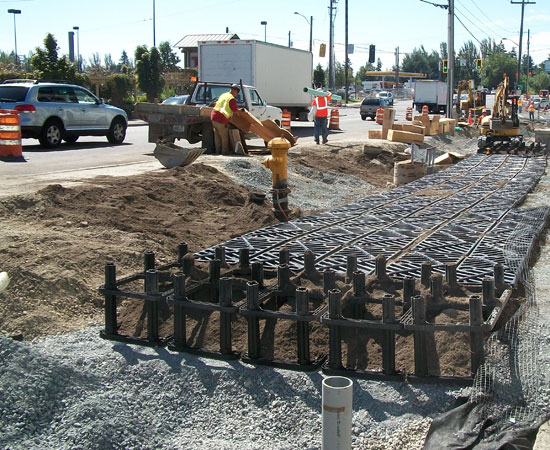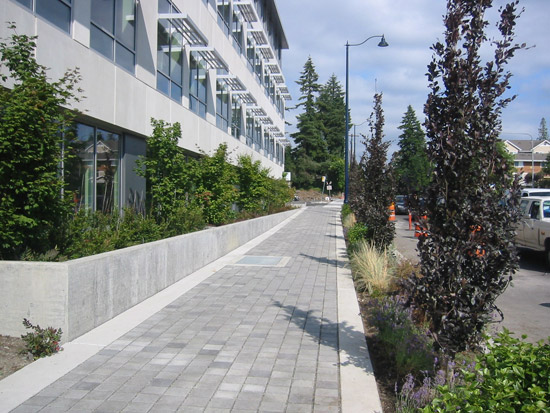Trees Need Dirt
As a soil cell system can utilize most of the loamy soils that are found at project sites, and as there is no need for including stone aggregate in the soil layers, there is less of a need for processing, mixing and delivering the soil mixture to the project site and thus, there can be an energy savings. The recycled plastic modules along with the use of local soils can contribute points towards meeting sustainable design criteria.
 |
A concept sketch showing how the soil cell system functions. Image courtesy of DeepRoot Green Infrastructure |
The following table provides a summary of the characteristics comparing a soil cell system and a structural soil system.
| CHARACTERISTIC | STRUCTURAL SOIL | SOIL CELL |
| Best soil type for use with product | Specific clay loam soil texture | Variety of soil types many of which are existing at site |
| Efficiency of Loam-soil volume | 20% | 92% |
| Soil character | Clay—loam, rapidly draining | Fine grained loam, slow draining |
| Water harvesting availability | Good | Good |
| Capillary capability | Fair with water lost to vertical drainage | Good with wider, more even distribution of water |
| Rainwater retention effectiveness | Rapid draining (approx. 24 inches per hour) so waters is not effectively retained. Pollutants cannot be effectively filtered | Slow draining so water is retained. Pollutants can be effectively filtered. |
| Sustainability criteria | Made from process hard aggregates that require significant energy to mine, crush and ship. High energy footprint due to shipping and large volume of materials | Lower energy footprint due to lower volume of soil materials. Locally sourced soils and recycled plastic materials are used. |
The following are some Case Studies illustrating the applications where a soil cell system has been used to meet sustainable design criteria by:
1. Containing and managing storm water
2. Augmenting the tree canopy and reducing heat island effects
3. Providing shelter for wildlife and promoting biodiversity and
4. Enhancing community aesthetics
Managing Storm Water via a Soil Cell System
Vandergrift, Pennsylvania has been at the forefront of developing design guidelines for urban forests as well as implementing projects to enhance their urban forests. The Vandergrift-streetscape project occurred in an old historic district. The project designers explored a number of options to help them minimize CSO and water quality problems while nourishing large tree growth within the streetscape. The project designers decided to use a soil cell system to manage storm water and CSO issues. Because this was an existing urban streetscape, the use of a soil cell system allowed the designers to provide a quality planting condition for trees with minimal change to the urban fabric. The designers were able to use the native soils at the site and underdrains were provided for future connections.
Use of modular underground bioretention cells around existing utilities was a factor considered by the designers at the Aurora Avenue Secret Rain Garden along Route 99 near Seattle Washington. A rain garden was designed along one side of a roadway to provide a separation for pedestrians. The designer, Curtis LaPierre of Otak, Inc. created a design that integrated permeable pavers, curb cuts and a modular underground bioretention cell system. These modular underground bioretention cells extended the rain garden underneath the pavement. Storm water from the road enters the rain gardens through the pavement and curb cuts and is absorbed into the soil, providing irrigation for the plantings as well as recharging of the groundwater. The project area had a limited right of way and large paved areas. The design solution provided additional traffic lanes, wider sidewalks, better storm water management and increased green space.
 |
The Aurora Avenue streetscape project in Seattle, Washington during the installation of a soil cell system. Photo courtesy of DeepRoot Green Infrastructure |
As more municipalities update their codes and design guidelines for increased on-site storm water management and increased urban forest canopy, a modular underground soil cell system provides an option for achieving these criteria. In this case study, the modular underground soil cell system provides the structure to support the overlying pavement while creating an underground vault for containing soil and managing water. This integrated system of soils within a modular underground support frame provides a larger and better planting medium for urban trees, creates a simple and effective method of capturing and treating rain and storm water at the source, and allows designers to plan for more extensive, functional, and sustainable urban green space.
 |
The Aurora Avenue streetscape project in Seattle Washington utilized a soil cell system to capture storm water into rain gardens. Photo courtesy of DeepRoot Green Infrastructure |









